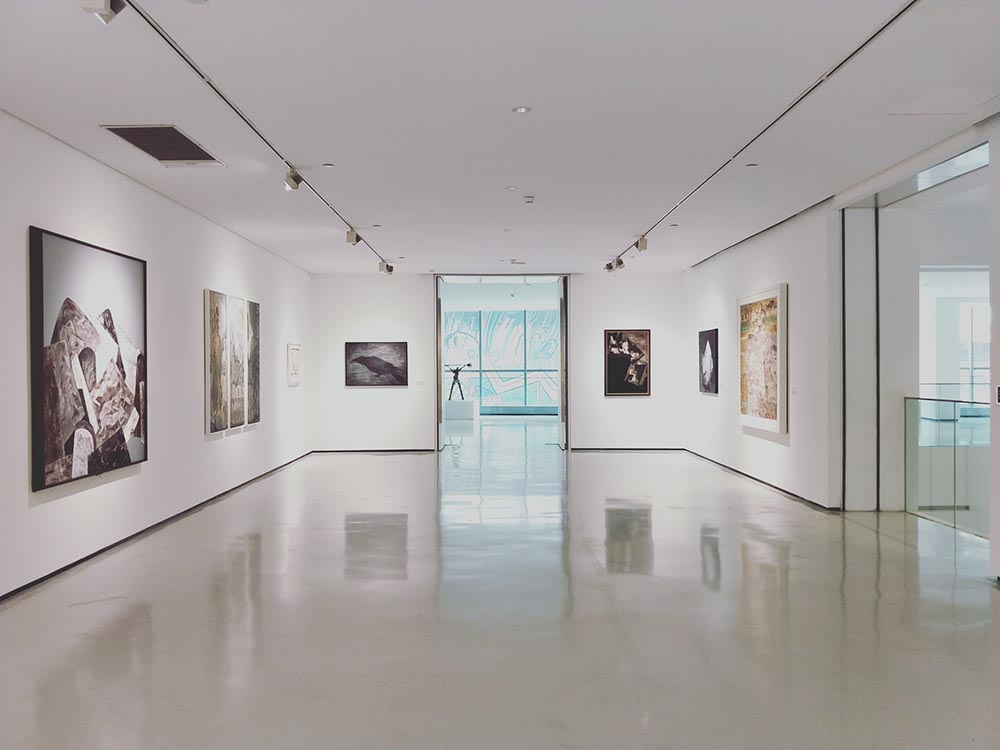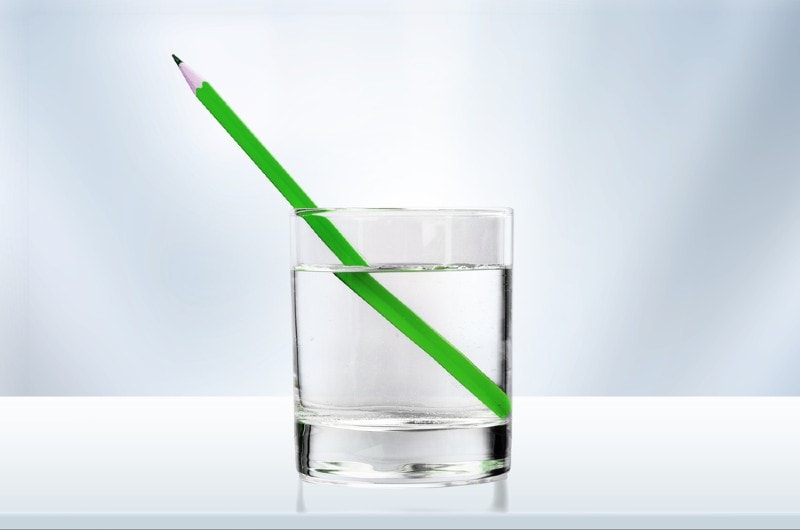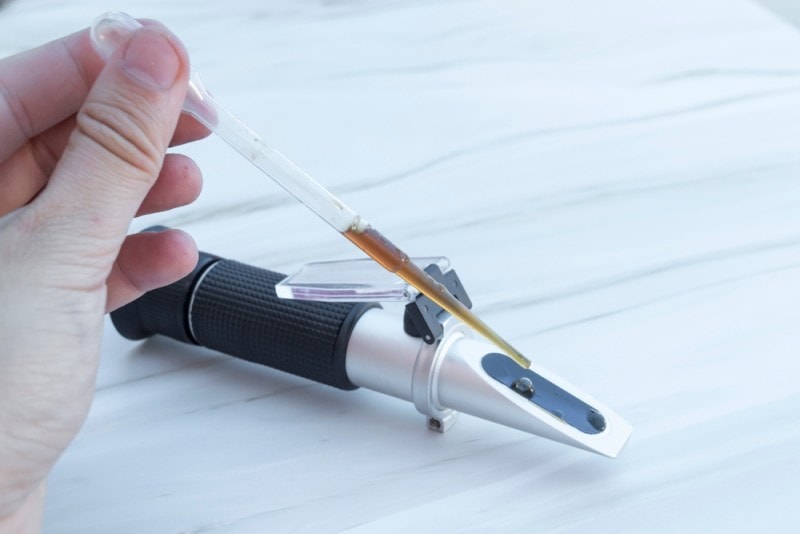Reflection vs. Refraction: What’s the Difference?
Last Updated on

Refraction and reflection are characteristics of light that often confuse people. Reflection happens when light bounces off an object, and refraction occurs when light passes through an object.
Light consists of tiny particles called photons. When photons bounce off an object, they reflect the light. That’s why you can see your reflection in a mirror. Likewise, when photons pass through an object, they refract the light.
The guide below explains the difference between both phenomena. We also describe the applications of reflection and refraction in our everyday lives.

Overview of Reflection

When light waves bounce off a surface, we see a reflection. The angle between the light that hits the surface, and the angle of the reflected light waves determine how much reflected light we see.
The amount of reflected light also depends on the nature of the reflecting surface. For example, a smooth, shiny surface reflects more light than a dull, rougher surface.
Mirrors reflect light in a straight line. So, we see a clear image. When light waves hit a curved surface, they bounce off at different angles. The waves reflecting off the curved surface interfere with each other, producing a distorted image.
Light waves reflecting off a surface can produce specific effects. When light reflects off a concave surface, it forms a real image. A convex surface forms a virtual image.
Examples of Reflection
The most common example of reflection is a mirror. However, you must have noticed that a mirror shows a left-right reversal of the image.
It happens because light waves change direction when they bounce off a mirror. The angle between the incoming and reflected light waves is the same.
Another typical example of reflection is the surface of a still pond or lake. When light reflects off the smooth surface of the water, it produces a clear image. Similarly, you can also see your reflection on your phone’s screen.
Types of Reflection
There are three types of reflection of light. They differ based on the type of object and angles created by the light.
Diffuse Reflection
In diffuse reflection, the light that hits an object is scattered in many directions. It happens when the surface is not smooth.
The light waves hit the rough surface and bounce off in different directions. Diffuse reflection is responsible for the image we see in a mirror.

Specular Reflection
Specular surfaces are smooth and shiny, like a mirror. The light waves bounce off these surfaces at a definite angle.
The angle between the surface and the reflected ray equals the angle between the surface and the incident ray. Specular reflection has applications in lasers, telescopes, and periscopes.
Glossy Reflection
Glossy surfaces are a type of specular surface, except that they have micro surfaces at an angle to the plane of the surface. The micro surfaces scatter the light in many directions.
It results in a reflection that is not as sharp as specular reflection. We see glossy reflections in car paint and accessories.

Overview of Refraction

Refraction occurs when waves travel through a medium and bend due to a change in their speed. The change in speed can be due to the waves traveling from one medium to another or the waves traveling through a medium with different properties in different regions.
The amount of bending depends on the difference in the speed of the waves in the two regions. For instance, when light waves travel from air into water, they are bent toward the normal (the line perpendicular to the surface where the incidence strikes) because the speed of light is slower in water than in air.
The amount of bending also depends on the refractive index. The refractive index is the ratio of the speed of waves in a vacuum to the speed of waves in a medium. For example, water’s refractive index is 1.33. Meanwhile, the air’s refractive index is 1.00. Therefore, when light enters a medium with a higher refractive index (air to water), it slows down. Thus, it bends towards the normal line. When light travels from a medium with a lower refractive index to one with a higher refractive index, it bends away from the normal.
Examples of Refraction
Refraction occurs in many everyday situations. The most notable example is the human eye. The human eye uses refraction to allow us to see. When light enters the eye, refraction occurs in the cornea. The cornea is the clear, curved front surface of the eye. It has a higher refractive index than the air, so it bends the light waves as they enter the eye.
Then, the lens, a clear, curved structure behind the cornea, refracts the light. Finally, it further bends the light so that it focuses on the retina.
You can also notice refraction when you are swimming. For example, when you look at the bottom of a pool, it may appear closer than it is. You have this illusion because the water bends the light waves, making the bottom of the pool appear closer than it is in reality.
This same principle applies to other objects that are submerged in water. For example, a straw in a glass of water appears bent because the light waves are bent as they travel from the air to the water.
Another notable example of refraction is rainbow formation. When light hits water droplets, it is bent and refracted. Each wavelength bends at a different angle. That’s why you see seven colors of the rainbow.
Types of Refraction
The types of refraction depend on the density of the media. Here are the two standard types.
Dense to Rare
As mentioned earlier, when light passes from rare to dense medium, it bends towards the normal. As a result, the angle of incidence is larger than the angle of refraction.
Rare to Dense
When light rays go from a dense to a rare medium, the angle of incidence is smaller than the angle of refraction. That’s because the light waves bend away from the normal in this case.
In general, the refractive index of a medium is directly proportional to the speed of light in that medium. The higher the refractive index, the slower the speed of light in the medium.

Applications of Reflection
Besides the mirror, reflection has many applications in our daily lives. Here are some of them.
Meters
Mirrors are present in voltmeters, ammeters, and other meters to prevent parallax errors. These errors occur when the user takes the reading while looking at an angle rather than directly from the back of the meter.
Mirrors are present on the back of the meter. When the user looks into the mirror, they see the reading at eye level. The user can take an accurate reading without worrying about the parallax error.

Automobile Mirrors
If you drive, you use reflection every time you get in your car. Rearview mirrors and side-view mirrors allow you to see what is behind and to the sides of your vehicle. These mirrors use flat or convex mirrors to give you a wider field of view.
Microscopes
Microscopes use concave mirrors to reflect light into the specimen. These mirrors are usually adjustable so the user can focus on the image.
The magnification depends on the curvature of the mirror. When light reflects off a concave mirror, it is focused. Therefore, the closer the object is to the mirror, the greater the magnification.
Overhead Projectors
Have you ever wondered how an overhead projector works? These projectors use a concave mirror to reflect light onto a screen. The image projects upside down, but the mirror flips the image, so it is right-side up.
Fiber Optics
Nowadays, fiber optics have become an important technology. Fiber optics cables transmit information from one place to another over long distances. The technology is instrumental in telephone and internet lines, cable television, and medical equipment.
Fiber optics use thin glass or plastic fibers to carry light. The light waves reflect off the walls of the fiber and travel along it.
The basic principle of fiber optics is total internal reflection. The core and cladding of the fiber must have different refractive indices. Therefore, the light waves reflect when they pass from the core into the cladding.

Applications of Refraction
Many modern devices make use of the refraction of light. Here are some examples.
Lenses
All lenses work by refraction since they have at least one curved surface. The curve makes the lens thicker in the middle than at the edges.
Light waves passing through the lens are bent. It makes the lens act like a magnifying glass. Lenses are present in cameras, microscopes, binoculars, and other optical devices.
Prism
Prisms are common in many optical devices, including cameras, projectors, and lasers. They can separate white light into different colors. For instance, the prism bends and focuses the light onto a camera’s film or image sensor.

Spectacles
Spectacles for defective vision use convex lenses. They make distant objects appear larger and, therefore, closer.
The lens refracts the light from these objects and focuses it onto the retina at the back of the eye. As a result, the person wearing these spectacles can see better.
Difference Between the Law of Reflection and Refraction
The law of reflection states when a light ray reflects off a surface, the angle between the beam of light and the surface is equal to the angle between the ray of light and the line perpendicular to the surface (the normal).
Meanwhile, Snell’s law is the law of refraction. It states that when a ray of light passes from one medium to another, the ratio of the angle of incidence’s sine to the sine of the angle of refraction is constant. The constant is known as the index of refraction and is different for every pair of media.

Final Thoughts
While reflection is the bouncing off of light, refraction is the bending of light. Light exhibits both these properties due to its wave-like nature.
When light waves encounter an obstruction, they scatter in all directions. However, light waves bend when they encounter a boundary between two different mediums. The phenomena occur because light waves travel at different speeds in different mediums.
Image Credit: Left – Juan Pablo Serrano Arenas, Pexels, Pixabay; Right – ScienceGiant, Pixabay
About the Author Jeff Weishaupt
Jeff is a tech professional by day, writer, and amateur photographer by night. He's had the privilege of leading software teams for startups to the Fortune 100 over the past two decades. He currently works in the data privacy space. Jeff's amateur photography interests started in 2008 when he got his first DSLR camera, the Canon Rebel. Since then, he's taken tens of thousands of photos. His favorite handheld camera these days is his Google Pixel 6 XL. He loves taking photos of nature and his kids. In 2016, he bought his first drone, the Mavic Pro. Taking photos from the air is an amazing perspective, and he loves to take his drone while traveling.
Related Articles:
How to Clean a Refractor Telescope: Step-by-Step Guide
How to Clean a Telescope Eyepiece: Step-by-Step Guide
How to Clean a Rifle Scope: 8 Expert Tips
Monocular vs Telescope: Differences Explained (With Pictures)
What Is a Monocular Used For? 8 Common Functions
How to Clean a Telescope Mirror: 8 Expert Tips
Brightfield vs Phase Contrast Microscopy: The Differences Explained
SkyCamHD Drone Review: Pros, Cons, FAQ, & Verdict
